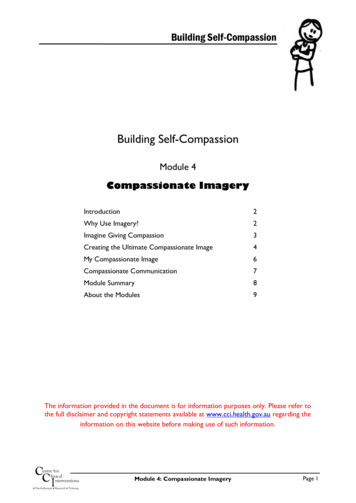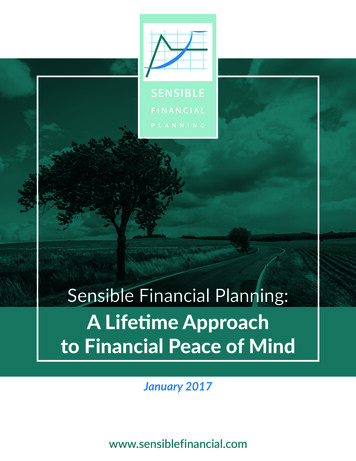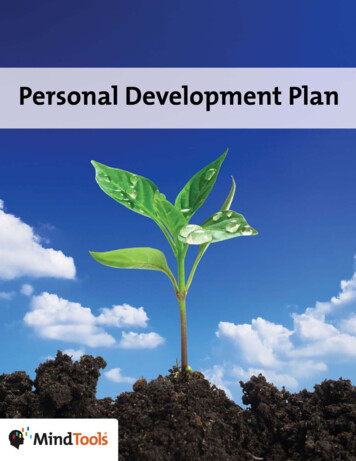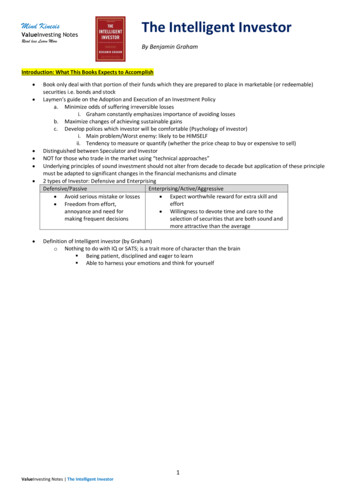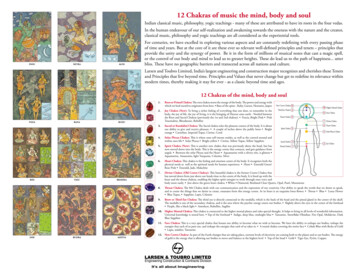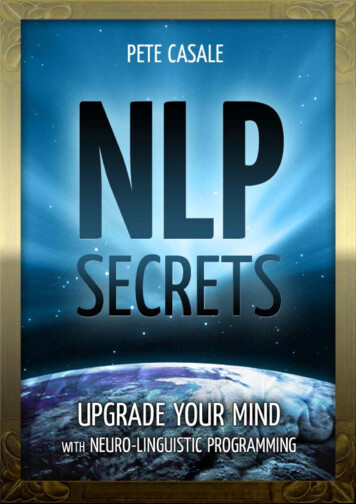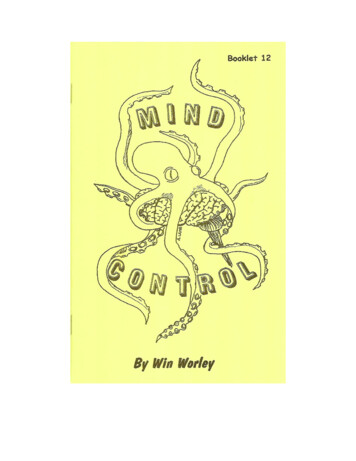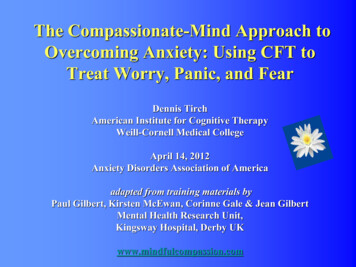
Transcription
The Compassionate-Mind Approach toOvercoming Anxiety: Using CFT toTreat Worry, Panic, and FearDennis TirchAmerican Institute for Cognitive TherapyWeill-Cornell Medical CollegeApril 14, 2012Anxiety Disorders Association of Americaadapted from training materials byPaul Gilbert, Kirsten McEwan, Corinne Gale & Jean GilbertMental Health Research Unit,Kingsway Hospital, Derby UKwww.mindfulcompassion.com
Our Talk TodayOutline basic philosophy and model ofCompassion Focused Therapy (CFT)Note the powerful effects of our selfevaluation systems (self-criticism vs selfcompassion)Explore the application of CFT to thetreatment of Anxiety
The human brain is the product of many millions of years ofevolution – a process of conserving, modifying and adapting
To understand ourselves we mustunderstand our brains
why we have complex brains and minds that aredifficult to understand regulate1. Old BrainEmotions:Behaviours:Relationships:Anger, anxiety, sadness, joy, lustFight, flight, withdraw, engageSex, status, attachment, tribalism2. New Brain– Imagination, fantasise, look back and forward, plan, ruminate– Integration of mental abilities– Self-awareness, self-identity, and self-feeling3. Social BrainNeed for affection and careSocially responsive, self-experience and motivesWhat happens when new brain is recruited to pursue old brain passions?
Interactionof oldofandnew psychologiesSourcesbehaviourNew Brain: Imagination,Planning, Rumination, IntegrationOld Brain: Emotions, Motives, RelationshipSeeking-CreatingArchetypal
Understanding our Motives andEmotionsMotives evolved because they help animals tosurvive and leave genes behindEmotions guide us to our goals and respond if weare succeeding or threatenedThere are three types of emotion regulation1. Those that focus on threat and self-protection2. Those that focus on doing and achieving3. Those that focus on contentment and feeling safe
Types of Affect Regulator SystemsContent, safe, connectedDrive, excite, vitalityNon-wanting/Affiliative anting, pursuing,achieving, n andSafety-seekingActivating/inhibitingAnger, anxiety, disgust
Types of Affect Regulator SystemsContent, safe, connectedDrive, excite, vitalityNon-wanting/Affiliative anting, pursuing,achieving, n andSafety-seekingActivating/inhibitingAnger, anxiety, disgust
Self-ProtectionIn species without attachment only1-2% make it to adulthood toreproduce. Threats come fromecologies, food shortage, predation,injury, disease. At birth individualsmust be able to “go it alone” bemobile and disperse
Dispersal and avoid others
Protect and Comfort: Less ‘instinctivebrain – post birth learning
The Mammalian Importance ofCaring MindsCaring as “looking after”. Seeking closenessrather than dispersion. Individuals obtainprotection, food, and care when ill. Key also issoothing-calming and physiological regulation.Few offspring but high survival rate incomparison to species without attachment.Affection and kindnessCo-operative and mutual support can develop aswe see that our prosperity impacts on that ofothers, sharing and not-exploiting
Self-CompassionHigher levels of reported self-compassion have beenfound to be correlated with lower levels of depressionand anxiety (Neff, 2003; Neff, Hseih, & Dejitthirat,2005; Neff, Rude, & Kirkpatrick, 2007).Neff and colleagues’ research has demonstratedpositive correlations among self-compassion and arange of positive psychological dimensions (Neff,Rude, et al., 2007). These factors include, but aren’tlimited to life satisfaction, feelings of socialconnectedness (Neff, Kirkpatrick, & Rude, 2007), andpersonal initiative and positive affect (Neff, Rude, etal., 2007).
Internal Threat and SoothingSelf-affiliation – experiencesa lovable selfCalmsAffiliative/SoothingThreatInternal representations of helpfulothers and sources of comfortNeurophysiologicalnetworksEmotional memories of soothing
Internal Threat and More threatNo self-affiliation –experiences a hysiologicalnetworksOthers are threats oralarmingEmotional memories of nosoothing
Compassion SolutionsAncient wisdomCompassion is the road to happiness(Buddhism)EvolutionEvolution has made our brains highlysensitive to internal and external kindnessNeuroscienceSpecific brain areas are focused on detectingand responding to kindness and compassion
CompassionCompassion can be defined in many ways: “As asensitivity to the suffering of self and others with adeep commitment to try to relieve it” Dalai LamaEight fold path - represents a multi-modalapproach for training one’s mind
Compassion as FlowDifferent practices for eachOtherSelfSelfOtherSelfSelfNon linear empathy for other begins early in life
Data Practice of imagining compassion for others produces changes infrontal cortex and immune system (Lutz et al, 2009) Loving kindness meditation (compassion directed to self, thenothers, then strangers) increases positive emotions, mindfulness,feelings of purpose in life and social support and decreases illnesssymptoms (Frederickson et al, 2008, JPSP) Compassion meditation (6 weeks) improves immune function,and neuroendocrine and behavioural responses to stress (Pace,2008, PNE) Compassion training reduces shame and self-criticism in chronicdepressed patients (Gilbert & Proctor, 2006, CPP)
Key Targets of ivationBehaviourEmotionsTheir pattern gives rise to a certain type of mind
Compassionate ningCompassionEmotionsBehaviour
Threatened Mind can block MotivationThreatBehaviourEmotions
Self-Critical Mind is also yFantasyMotivationSelfCriticalBehaviourEmotions
How our own thoughts and images affect our brainsSexualBully-threatMealMealSexEmotion BrainBullythreatKind, warmand caringCompassionSoothedSafeStomach acidSalviaFearfulArousalPink represents our inner images and thoughtsDepressed
Compassionate ningSelfCompassionateEmotionsBehaviour
Why a Compassion Focus?People with chronic problems often come fromneglectful or abusive backgrounds, have highlevels of shame, and are often self-critical, selfdisliking, or self-hatingLive in a world of constant internal and externalthreatHave few experiences of feeling safe or soothedand are not able to do this for themselves. Oftendo poorly in trials
Internal Threat and onateimagery
Fear of CompassionCertain types of positive feelings are threateningIt is dangerous to feel safeCompassion feeling are linked to beliefs such thatit’s an indulgence and weaknessActivated grief and or abuse memories
PROBLEM -Compassion is a lizingFear ofclosenessTraumaMemoryMeta- beliefs
Kindness, Attachment and ThreatKindness from therapist or imageryFight, flightshut downActivate attachment systemActivate memoriesNeglectalonenessFight, flightshut downAbuse, shamevulnerableActivate learnt and current defences - cortisolBowlby: Kindness opens the attachment system and then whatever ever fears, angeror despair is coded there will become available and can be intensely threatening
TherapyLife history and contextual rather than symptom focusedBackground,key threats,safety strategiesundesired/unintended consequenceHigh focus on validation, on “not your fault,” courage anddoing your best.Clarify three circle model and why we will explore helpfulbehaviour for each circlesDesensitisation to affiliative positive affect – to be able tofeel safe and self compassionate
Paul Gilbert, Kirsten McEwan, Corinne Gale & Jean Gilbert Mental Health Research Unit, Kingsway Hospital, Derby UK www.mindfulcompassion.com www: Compassionatemind.co.uk
